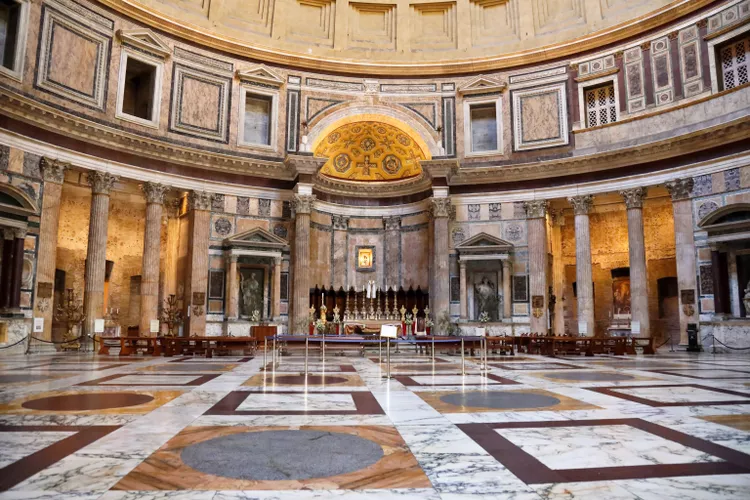1. Overview of the Pantheon
The Pantheon stands as the most complete Roman structure on earth, having survived 20 centuries of plunder, pillage, and invasion.
2. Facts About the Pantheon
The original Pantheon was a rectangular temple built by Marcus Vipsanius Agrippa, son-in-law of Augustus, the first Roman emperor. This construction was part of a district renewal plan between 27-25 BC. Tourists today see a structure radically different from the original temple. Moreover, Hadrian rebuilt the structure, and the maker’s stamps in the bricks allow us to pinpoint this restoration between 118 and 125 AD. Interestingly, the inscription on the architrave attributes the construction to Agrippa during his third councilship. The remaining portico is a remnant of Agrippa’s original temple.
The Pantheon houses the tombs of notable figures, including Rafael and several Italian kings. The term Pantheon is derived from Greek, meaning “to honor all Gods.”
3. Dimensions of the Pantheon
The impressive dome that dominates the interior measures 43.30 meters, or 142 feet in diameter. For comparison, the White House dome is 96 feet in diameter. The Pantheon held the title of the largest dome until Brunelleschi’s dome was completed at the Florence Cathedral from 1420-36. It remains the largest masonry dome globally. The design achieves perfect harmony, as the distance from the floor to the top of the dome is equal to its diameter. Adytons (shrines recessed into the walls) and coffers (sunken panels) ingeniously reduce the dome’s weight, alongside the lightweight pumice cement utilized in the upper levels. The dome’s thickness decreases as it approaches the oculus—the opening at the dome’s top that provides light to the interior. Its thickness at this point is only 1.2 meters.
The oculus itself measures 7.8 meters in diameter. While rain and snow may occasionally fall through it, the floor’s slant and the cleverly designed drains prevent water accumulation. Consequently, rain seldom reaches the interior floor.
The grand columns supporting the portico weigh a staggering 60 tons each. Each column stands 39 feet (11.8 m) tall, with a diameter of five feet (1.5 m), crafted from stone quarried in Egypt. Remarkably, these columns were transported by wooden sledges to the Nile, barged to Alexandria, and then shipped across the Mediterranean to Ostia, before finally making their way up the Tiber by barge.
4. Preservation of the Pantheon
Similar to many historical buildings in Rome, the Pantheon was preserved from destruction by converting it into a church. Byzantine Emperor Phocas donated the monument to Pope Boniface IV, who transformed it into the Chiesa di Santa Maria ad Martyres in 609. Special masses are conducted here on particular occasions.
5. Visitor Information for the Pantheon
The Pantheon maintains a website with real-time updates on opening hours and special events, and there is no admission fee.
An intriguing event during spring is the celebration of the Mass of Pentecost, occurring 50 days after Easter. During this event, firemen climb to the top of the dome to release rose petals from the oculus. If you plan to attend, arriving early could grant you a chance to secure a few inches of floor space for viewing this popular spectacle.
6. Experiencing the Pantheon
The Piazza della Rotonda is vibrant with cafes, bars, and restaurants. In summer, it is advisable to visit the Pantheon’s interior during the quieter morning hours before crowds arrive. Returning in the evening provides a chance to witness a lively atmosphere, especially on warm nights when the Pantheon is illuminated from below, standing as a magnificent reminder of ancient Rome’s grandeur. Visitors can often find the steps around the piazza bustling with the penny-pinching backpack crowd, while other tourists enjoy the bars lining the square. While drinks may be on the pricier side, they are not outrageously expensive, and you can enjoy one leisurely without feeling rushed—a simple pleasure of European life.
The surrounding restaurants may not always meet expectations in quality, but they offer an unparalleled view and atmosphere. For excellent Roman cuisine at a nearby establishment, consider dining at Armando al Pantheon, tucked in a small alleyway to the right of the Pantheon when facing it. To enjoy the best coffee, visit Tazza d’Oro located close by.





